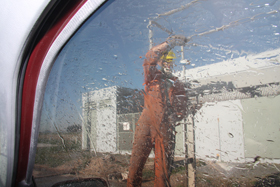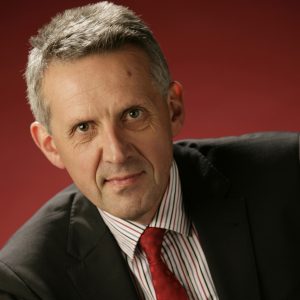Ovobrand, Argentina: Top quality egg products for the world market

Situated near the Argentine capital Buenos Aires are the Ovobrand premises. This recently founded company with its brand new facilities, is an integrated operation, fully aiming at industrial egg processing. They have everything under control, from rearing and feed manufacturing to packing the processed end products. Thus, they can guarantee top quality to their highly demanding customers around the world.
By Ad Bal
“The future is food”, was the conviction of the founders of Ovobrand, when they decided to step into the egg processing business in 2007. The board of directors of Ovobrand, headed by their president Claudio Farina, had been involved in various kinds of businesses. Some of these were mainly focused on the domestic market in Argentina, such as in construction. Together they therefore decided to set up a very high standard integrated operation which is fully dedicated to egg processing. This allows the company to be active on the world market, rather than just on the domestic market. Otherwise, they would have gone into producing table eggs only. But by stepping into egg processing, the road to the world market was opened.
This strategy automatically included that the new operation should meet the highest quality standards. And this is truly the case, as all was built from scratch. Not just that, all new staff are also very well experienced specialists. The fully integrated Ovobrand operation started producing in December 2010 and is currently still expanding its capacity.
Biosecurity is key
When entering the Ovobrand premises, it is immediately clear that this is a state of the art facility. Biosecurity measures are key. To start with the feed plant is located before the entrance gate, thus all ingredient suppliers have to stay outside the premises.
When entering the Ovobrand premises, it is immediately clear that this is a state of the art facility. Biosecurity measures are key. To start with the feed plant is located before the entrance gate, thus all ingredient suppliers have to stay outside the premises.
Only the trucks of Ovobrand themselves have access to the poultry houses. “We are producing high quality products and we wish to avoid every possible chance of contamination at the premises”, says Farina. “Our strategy is to have everything under control on one spot, in order to guarantee the highest possible quality, which is essential in a processing plant. That’s why we have chosen for the concept of full integration. The entire project is located on a 1,300 hectare surface of land. Of course this is not big enough to grow our own feed ingredients, but at least we can produce some of it under our own control”.
Behind the feed mill is the main entrance to the facilities. Here all vehicles must go through the sanitation gate. This is not just a water bath device to only disinfect the wheels and a gate with sprinklers. Instead, each vehicle is cleaned under high pressure and with disinfectants. Disease agents may be hidden in the dirt layer that covers the vehicle. Thus, by cleaning it with high pressure, the dirt including a possible disease source will fully disappear. Also vehicles of visitors are not allowed on the premises. They are requested to step into a company car that is taking them to the houses.
On site rearing
Although Ovobrand currently have over one million layers, their size does not allow an own hatchery. So Hy-Line distributor Motta in Argentina is supplying day old chicks of the Hy-Line W36 strain. However, the rearing houses each have a capacity of 130,000 birds. But the incubation capacity of Motta or any other hatchery in the region, can not facilitate the supply of 130,000 chicks in one batch. For that reason, each rearing house of Ovobrand has a solid wall to internally separate them in two sections. Thus two groups of chicks can be reared separately in one house and in full accordance with the Hy-Line guidelines.
Although Ovobrand currently have over one million layers, their size does not allow an own hatchery. So Hy-Line distributor Motta in Argentina is supplying day old chicks of the Hy-Line W36 strain. However, the rearing houses each have a capacity of 130,000 birds. But the incubation capacity of Motta or any other hatchery in the region, can not facilitate the supply of 130,000 chicks in one batch. For that reason, each rearing house of Ovobrand has a solid wall to internally separate them in two sections. Thus two groups of chicks can be reared separately in one house and in full accordance with the Hy-Line guidelines.
They are kept in Big Dutchman cages in the 3 + 3 system with a catwalk in between (6 tiers). This allows having all the birds under direct veterinary control and to guarantee that the vaccination scheme is carried out correctly and effectively.
House to house
“Chicks in their early stage of life are very vulnerable to external factors”, says Dr. Gustavo von Bassenheim. Apart from being the CEO and vice-president of Ovobrand, Von Bassenheim is responsible for the technical part of the entire company. “Good rearing is the basis for good laying performance”, he continues.
“Chicks in their early stage of life are very vulnerable to external factors”, says Dr. Gustavo von Bassenheim. Apart from being the CEO and vice-president of Ovobrand, Von Bassenheim is responsible for the technical part of the entire company. “Good rearing is the basis for good laying performance”, he continues.
As such, the rearing flocks are managed and monitored with great care. Ovobrand has two identical rearing facilities. These are located at a distance of two kilometres from the layer houses and also one kilometre from each other. “Again this is for biosecurity reasons”, says Von Bassenheim. There are wire fences around the rearing facilities and visitors cannot go inside, unless they have a good reason. In any case they must shower anyway.
Each farm has its own and exclusive equipment to avoid any transfer from house to house, reducing the risk of cross contamination neither cross vaccination. Ovobrand also has its exclusive vaccination team who don’t visit any other facilities. When no vaccination needs to be done, they keep busy doing maintenance and cleaning.
There are rodent traps around the fence, keeping them away from the houses. Also the surrounding lawn is a smooth surface and there’s no grass underneath the fence. “In each rearing house we keep exactly the number of birds which are needed for one layer house”, von Bassenheim says. “We stick to the house-to-house principle, meaning that after 16 weeks of rearing, a full house is transferred to a layer house. So far we have been successful in the rearing stage. In the worst case we had 1.68% mortality, but we have also reached 1.22% only. This is well below the Hy-Line standards, so we think that we are on the right track.”
Everything in-line
Currently Ovobrand have 10 layer houses with a capacity of 128,000 birds each. These have been built by Facco and Big Dutchman. The birds are kept in 2 x 4 tier battery cages, with a catwalk in between. Roof insulation and tunnel ventilation with pad coolers keeps the climate inside at the desired level. Everything is computer controlled through the BD and Facco management programs. The layers start producing at 19 weeks of age. The eggs are taken to the processing plant by an inline conveyor belt which runs through and in between, connecting all the houses.
Because the houses are 148 meters long with cage rows of 136 meters, water pressure in the drinker lines may drop towards the end. For that reason, water supply is coming from two sides. The objective of Ovobrand is to keep their laying flocks antibiotics free.
Moreover, they are fed GMO-free ingredients. Since Ovobrand have many overseas customers, they must guarantee that their products are GMO-free, for which purpose they are certified by national and international (European and Japanese) laboratories. Ovobrand also sends their products to these laboratories to analyse the possible presence of dioxins, different metabolites, etc. In a special certification programme in Japan, their products were analysed for over 850 different metabolites and these were 100% approved.
Focus on egg products
Eventually, the eggs arrive in the processing plant. “And this is the place where we put all our effort in producing high quality products”, say Farina and Von Bassenheim. Although the objective of Ovobrand is to only produce processed egg products, they also have a grading and packing line. This will only be used incidentally however.
Eventually, the eggs arrive in the processing plant. “And this is the place where we put all our effort in producing high quality products”, say Farina and Von Bassenheim. Although the objective of Ovobrand is to only produce processed egg products, they also have a grading and packing line. This will only be used incidentally however.
For that purpose there’s a kind of alternative track in the conveyor belt to take the eggs to the packing section. Most of the time they are going into the processing line however. Here they are washed and candled first and next go into the breaking machine. Depending on the customer, either white, yolk, or whole eggs are being processed. They produce both liquid and dried products.
All this takes place under very strict hygiene conditions. After breaking, the eggs move to the pasteurisation room and onwards to the drying and packing sections. In each stage the air pressure is slightly higher than in the previous stage. This is done to avoid possible contamination of the end product. Screens outside the rooms display the pressure differences inside. Visitors can only see the entire process from behind windows in an external corridor. Even there protective clothing must be worn, in order to meet with the hygiene and biosecurity standards. The plant is meeting EU regulations and is HACCP certified.
Ovobrand has their own laboratories to permanently check the quality of the end products. Here, also texture, colour and other characteristics are measured and adjusted to the customers’ preference. In order to have the same reference with their customers abroad, Ovobrand is using various measuring equipment like from Japan and from Germany. By doing so, they speak the same technical language.
All the sewage water of the plant is disposed of in the environmentally friendly “dry artificial swamps” on their own land.
Further expansion
Although Ovobrand has been producing for only one year now, they are exporting to many countries already, such as to Japan, Germany, Sweden, Denmark and Russia. About 80% of their production is being exported. The 20% for domestic use are both liquid and dry products.
Although Ovobrand has been producing for only one year now, they are exporting to many countries already, such as to Japan, Germany, Sweden, Denmark and Russia. About 80% of their production is being exported. The 20% for domestic use are both liquid and dry products.
Ovobrand is still expanding their facilities by adding five more houses with the same capacity of 128,000 birds each. As a result, total capacity will be close to two million layers in the near future. Also, a new rearing facility will be built to meet with the total layer volume.
Altogether this makes Ovobrand a very professional state of the art company that is fully focused on the egg processing industry. Gustavo von Bassenheim and Claudio Farina have full confidence that the unique approach of their integrated operation will make them specialists and producers of high quality egg products for the world market.
More Information
For a photo gallery on Ovobrand please visit www.worldpoultry.net/photos













